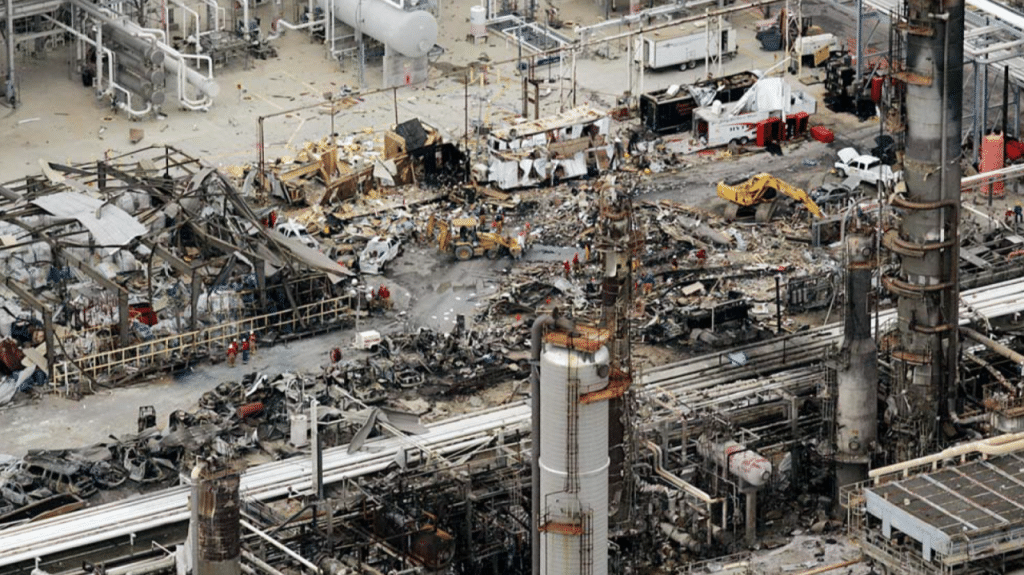
An explosion at BP’s Texas City refinery illustrates how an organisation’s structure can undermine the effective management of process safety risk.
The Incident
On 23 March 2005, a distillation column at BP’s Texas City refinery was overfilled, causing hydrocarbons to escape and subsequently ignite, resulting in an explosion. 15 people were killed and 180 injured.
While many factors contributed to this incident, this article focuses on the role played by BP’s organisational structure, namely, how the company’s reporting lines created a blindness to process safety risk, and how BP’s commercial structure rewarded decisions that were at odds with the management of this risk.
BP’s Reporting Lines
At the Texas City refinery, the site leader, known as the ‘Business Unit Leader’, was responsible for all aspects of the refinery, including its commercial, health and safety, and environmental performance.

While the site leader appears to have known very little about process safety, there was a site-based Process Safety Manager who understood the importance of managing process safety risk. They had even co-authored an article on an incident at BP’s Grangemouth refinery in Scotland in 2000, highlighting the deficiencies in BP’s approach to process safety.
The Process Safety Manager, however, could not directly influence the site leader regarding process safety risk management. This was because they did not have a direct reporting line to the site leader. Instead, they reported to the HSE Manager. But the HSE Manager did not have an understanding of process safety risk management, had little interest in obtaining it, and was more focused on the management of personal safety risk – the only safety metric in their incentive scheme.
The Process Safety Manager was also hindered from escalating concerns beyond the site. A corporate health and safety function was held by the Vice President (VP) for HSE, but this function had no connection with the Texas City refinery. There was no reporting link from the Process Safety Manager to the VP for HSE.

There was also no link in the opposite direction. While the corporate health and safety function from the VP for HSE produced standards for the BP sites, it played no role in ensuring these standards were actually met.

The responsibility for complying with these standards was decentralised and managed by each individual site, meaning that corporate HSE had no meaningful influence on how the site managed its process safety risk.
BP’s Commercial Structure
Given the lack of process safety influence from both the site and the corporate perspective, what was the site leader’s primary focus?
Again, BP’s organisational structure played a key role. Individual BP sites were treated as ‘freestanding commercial organisations’ – essentially separate business units – with each business unit responsible for hitting commercial targets, complying with regulations, etc. There was minimal oversight from BP corporate, and the oversight that did exist focused on ensuring that each business unit met cost-cutting targets. While financial performance was centralised, process safety risk management was not.
The Occupational Health and Safety expert Andrew Hopkins makes an insightful point regarding centralisation: if you want to understand what’s important to an organisation, look at what it centralises. For example, Hopkins notes how McDonalds centralises quality control, which makes sense given that McDonalds values a consistent customer experience.
At BP, cost-cutting was the focus and the sites responded accordingly. Over the course of many years, the site leadership at Texas City avoided spending money so they could meet their yearly commercial targets. This included avoiding spending on maintenance and training budgets for operators. It also included staff cuts, particularly at a supervision level. All of which contributed to the incident.
Closure
While the structure of an organisation may appear unrelated to the management of risk on the front line, Texas City teaches us that it is fundamental. If the structure does not actively prioritise and embed process safety, then it’s likely to undermine it. For Texas City, the organisational structure produced a situation where site leaders were simply rewarded for running down the plant, while they were blinded to the risks of doing so.

